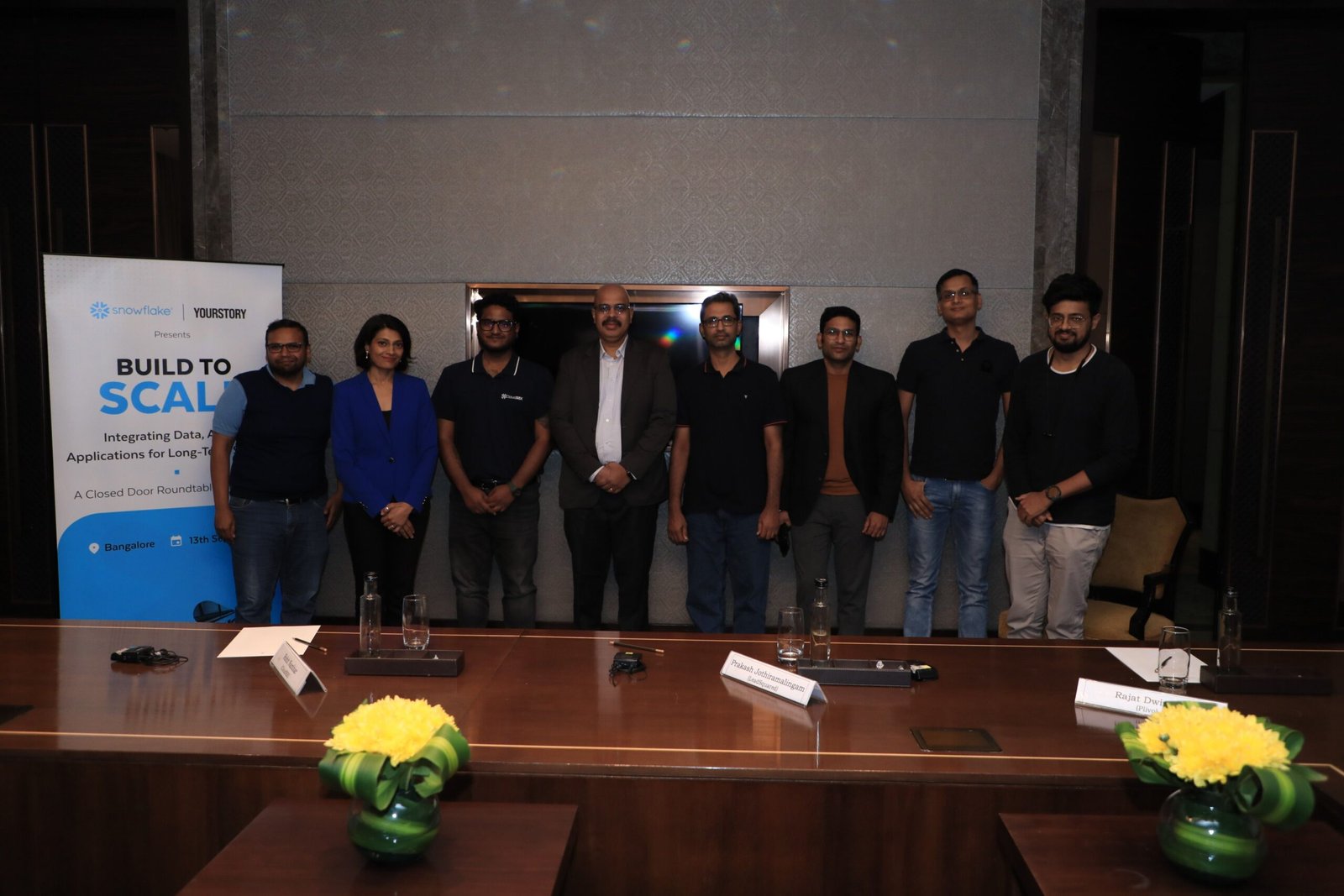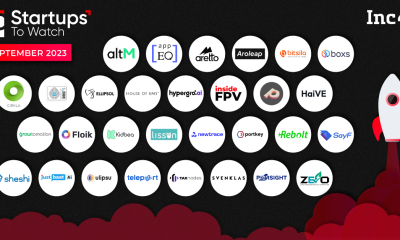Startup
EQT-backed Indium acquires majority stake in Experion

Private equity EQT backed-, an AI-driven digital engineering firm has acquired a majority stake in Experion, a global product engineering services company.
By utilising Experion’s end-to-end product engineering capabilities, Indium aims to help clients across sectors such as financial services, healthcare, manufacturing, retail, automotive, and transportation.
The acquisition’s financial details remain undisclosed.
“The synergies and complementary capabilities of Indium and Experion will meaningfully amplify our ability to deliver superior digital and product engineering solutions to customers. We are confident of unlocking multiple new opportunities with both existing and new clients, and have set a revenue target of $150 million for the next financial year,” said Ram Sukumar, CEO and Co-founder, Indium, according to a press release.
Additionally, the acquisition will expand the Chennai-based firm’s geographic footprint and workforce to 5,000 employees globally.
Founded in 2006, Experion offers capabilities in product strategy, engineering, cognitive computing, platform engineering, and experience design. The firm helps clients design, develop, deploy, and maintain products and platforms with proprietary IP.
“We are thrilled to be part of the EQT-Indium family, and Experion stands to benefit immensely from Indium’s market presence, diverse range of offerings and extensive experience working with global enterprises,” said Binu Jacob, CEO and Co-founder, Experion Technologies.
The company has also recorded a revenue growth of 30% CAGR over the past four years. Some of its clientele includes major enterprises in automotive, insurance, mining, and transportation industries, as well as ISVs and startups across North America, UK, Europe, Australia and Japan.
In December 2023, Hong Kong-based BPEA EQT Mid-Market Growth Fund acquired a majority stake in Indium Software from existing shareholders.
Startup
Experts weigh in on bringing scale and agility to complex data landscape

Data plays a pivotal role in today’s digital era, influencing the success of businesses worldwide. However, companies often find themselves in a fix on account of the volume of data, presence of multiple data sources in different locations, and varied quality of data. Hesitancy in changing data strategies and leveraging new technologies make it tough to boost efficiency and speed, integrate diverse data sources, and extract valuable insights in the long term.
This begs a question: can companies craft comprehensive and agile data strategies to create a lasting impact? Snowflake, in association with YourStory, brought together experts for a discussion on ‘Build to Scale: Integrating Data, AI, and Applications for Long-Term Success’.
The roundtable featured thought leaders and experts from a range of industries: Mrinal Rai, Co-founder and CPO, Intugine Technologies; Rohit Nambiar, VP of Engineering, CloudSEK; Venkata Rao, Head of Engineering, Needl.ai; Prakash Jothiramalingam, VP – Engineering, Lead Squared; Pramod Agarwal, CTO, IBSFINtech; Pradeep Sreeram, Head of Engineering, gnani.ai; and Rajat Dwivedi, Director – Engineering, Plivo.
The panel began with a short keynote address by Pravin Fernandes, Head, Commercial Business – Snowflake, India, and was moderated by Shivani Muthanna, Director – Strategic Partnerships & Content, YourStory Media.
The challenges of big data
Businesses and organisations now collect data from a range of sources, but it remains to be seen if it is being used effectively. The panellists shared challenges around using data effectively.
Mrinal Rai said Intugine Technologies had to manage many integrations to ensure that it was able to give clients 100% visibility. It also faced significant data sanitisation challenges.
“We have an infinite number of sources from which data comes. Our goal is to bring data on to a single platform, show it to our client in simple language so he knows where his shipment is, or if there are any delays/halts that can result in missing out on sales or deliveries. That is something we are trying to figure out,” he said.
Cloud SEK, a company that leverages AI to predict and prevent cyber threats, deals with an influx of data from all over the world. Nambiar shared how this data was necessary to help clients safeguard operations from cyber-attacks. He spoke about the need to discover new patterns in data to stay ahead of the curve and serve customers better.
Pramod Agarwal, of IBSFINtech, said that while data scaling wasn’t a problem, data variability was a challenge. He spoke about a variety of data structures generated by different financial instruments, citing unstructured data as the biggest challenge for the organisation.
Balancing the benefits of AI with its cost
The need for small language models (SLMs) was discussed at length. While large language models (LLMs) have made exciting advances in the field of AI, their size necessitates significant computing resources to operate, boosting the cost of operations.
Panellists discussed strategies to reduce the cost of running these models. They agreed that SLMs were ideal in a specific domain context. However, given the wide range of AI applications across industries, they agreed that a one-size-fits-all solution would prove ineffective. Most panellists recommended that companies balance factors like speed to market with the cost of AI.
Rajat Dwivedi, Director – Engineering, Plivo, spoke at length about his experience with LLMs. He shared that the company initially contemplated leveraging LLMs to follow others in the field. However, the leadership at Plivo recognised that this approach was incorrect.
He urged companies to find their problem statements first and then decide if an LLM, a dataset, or a retrieval augmented generation (RAG) pipeline could resolve it effectively instead of “choosing a solution and finding an issue for it to solve”.
Enhancing data protection and security
There is a growing need for enhanced security measures as enterprises continue to create and store vast amounts of data for analysis.
For Rohit Nambiar, VP of Engineering, CloudSEK, ensuring data privacy and security continues to be a complex endeavour. Companies must navigate various national regulations, while contending with international compliances. In India, financial entities are required to keep certain types of data, which requires overhauling data practices and staying agile in the face of ever-evolving governance laws.
Cloud SEK is building its own language model, but remains cautious about utilising the data, given the conflicting regulations in different regions. Nambiar also said that Cloud SEK runs the data through a stringent process for clients who opt for cloud over on-premises security. The company identifies the data, where it is taken from, where it will be stored, and who should have access.
Best practices for AI integration
Praveen Fernandes, of Snowflake, shared that data integration strategies should be unique to each and every organisation.
“We have seen people who leverage multiple data strategies, are on their own data journeys, or at a different stage of data maturity. Organisations know their businesses and are capable of identifying what strategy will work best,” he said.
Fernandes stressed that companies should be free to choose between a decentralised data mesh architecture or a data vault. This choice also comes down to the teams required to manage these architectures. For instance, opting for a decentralised approach like a data mesh means setting up a lean central team and having analysts and AI experts at every business unit, he said.
Assessments about required resources fall to individual business entities. Fernandes emphasised the importance of agility in choosing the right data strategies. He advised companies to stay agile in the face of failure, and switch to a new strategy to turn things around.
Bringing scale and agility to data infrastructure
Venkata Rao, of Needl.ai, shared that the challenge of building an app that scales is how companies manage their data layers. He advised companies to choose data strategies with care when they scale up. For instance, companies that use Open Search on AWS need to be sure of Elastic Block Storage (EBS) volumes and the amount of data consumed to avoid an increase in costs. Scaling of the app is dependent on how companies are able to scale their data layers, he said.
Panellists agreed that scaling horizontally helped them cope with growing demands and data. However, they cautioned companies to keep an eye on data infrastructure to ensure that scalability and uptime are maintained and discussed the cost of GPUs.
Prakash Jothirmalingam, of LeadSquared, said scaling is a continuous process. It is a journey, and companies’ expectations of products may change as they take this journey. In the initial phase, companies may strive to build their target base but once that is in place, the expectation shifts to where costs must be lowered while maintaining the same level of performance.
“Scale makes people humble. Whatever you know about architecture or engineering, the moment you start scaling, you realise that there is still something more to be done or learnt. I think it’s a journey and you can continue to evolve,” Jothirmalingam said.
Startup
No need to create demand in India. Just tap into existing need: Balancehero India COO

Did you know that credit behaviour and gaming apps are correlated? Alternative Credit Data, a credit assessment model, can indicate the possibility of bad credit behaviour in people who have more than three gaming apps on their phone.
That was one of the many fascinating insights Souparno Bagchi, COO of Balancehero India, shared in a fireside chat at TechSparks Bengaluru with Shivani Muthanna, Director – Strategic Partnerships & Content, YourStory.
Bagchi shed light on how location as a metric had replaced socio-economic metrics of creditworthiness with improvement in Indian digital infrastructure. As more and more digital highways came into the picture, mobile penetration and customers’ awareness towards digital transactions in terms of opportunities had emerged as two frontline indicators of the scale of financial inclusion, he said.
On the scale of opportunities in the Indian landscape at present, Bagchi said, “Financial inclusion is going beyond UPI payments and lending today. Even if we take a pragmatic approach, the lending is going to grow 3x to a figure of around $300 billion in the next three years – primarily from Tier II and plus cities.”
Balancehero India has created an impact on the fintech industry in recent years and its numbers do the talking. A whopping 87% of Balancehero India’s business comes from India’s Tier 2 and plus cities while the remaining 13% comes from the top eight cities. Its serviceability includes a staggering 97% of the total 90,100 pincodes in India. It disburses more than 12,000 fresh loans on a daily basis while more than 30 lakh customers apply for the loan on the app every month.
The conversation then moved to how Digital Payment Infrastructure (DPI) and India stack (Aadhaar, eKYC, UPI, Account Aggregators, etc.) have created a launchpad for Indian fintech solutions.
“We are fortunate as a country because we don’t need to create demand, we just need to tap the qualified demand. DPI is the backbone of what we do, day in and day out. From customer onboarding and identification to the level of underwriting, DPI helps us in everything. The adoption of account aggregators has also increased exponentially in the last few years,” Bagchi said. He added that DPI has evolved since inception and now helps fintech companies to not just know, but deeply understand customers.
The Balancehero COO credited First Loss Default Guarantee (FLDG) Guidelines for reducing the trust deficit among consumers, the ecosystem, and the players. Before these guidelines, banks and NBFCs were unsure about the degree of risk, he said.
“For me, the main premise of the digital lending space is FLDG Guidelines. It is a way to provide some level of guarantee to capital providers and channelise retail lending. In fact, India has inspired many other countries to adopt FLDG guidelines. Every country where there is a trust deficit is adopting these guidelines,” he said.
Bagchi also addressed the challenges fintech companies face due to constant changes in the regulatory system. “We need to understand that regulations are not speed bumps but guardrails,” he said. The more guardrails there are, the more safe space there will be for fintech players and consumers.
On how BalanceHero India is leveraging modern technologies like AI and ML, he called them “our bread and butter”.
He outlined the three stages: the first is verticalisation, delving deep into leveraging modern technologies. For example, in the case of lending, it’s underwriting. “Second, you start applying these technologies as per the use case. The third is responsible use of any other front-end technologies,” he said.
In a country as diverse as India, where the target audience of any fintech company can range from a person living in a rural area to a GenZ consumer, and consumption patterns are constantly shifting, it is a challenge to ensure responsible lending.
Bagchi feels lending can only be responsible when companies are 100% sure about their product and asset class from the very beginning. “We are very clear that we are in the non-discretionary space. Our focus is on people who need working capital, money for exigencies, for life events, festivities, etc. We are not in the business of consumer durable loans or giving loans to people for their next iPhone,” he said.
He emphasised the importance of collaboration when partnering with banks to enable more payments. “I strongly feel that collaboration expands the whole pie. You can collaborate on the scale of FLDG or co-lending. As a business, you know who can provide the capital, who can provide the guardrails of regulation, and who can be originators from the customer perspective,” Bagchi concluded.

Startup
Rich vs. Poor Nations: Nobel Economists Unveil the Hidden Power of Institutions

The Nobel Memorial Prize in Economic Sciences was awarded to Daron Acemoglu, Simon Johnson, and James Robinson for their revolutionary research on the relationship between institutions and economic inequality. Their theory offers a fresh perspective on a question that has puzzled economists and historians for decades: Why are some nations rich while others struggle with poverty?
The Big Idea: Institutions, Not Geography, Drive Prosperity
For many years, theories about wealth inequality pointed to factors like geography, culture, or even natural resources. Acemoglu, Johnson, and Robinson, however, shift the focus to institutions—the man-made political and economic systems that govern how societies function. Their research shows that the quality of institutions—how inclusive or extractive they are—determines whether a nation prospers or worsens in poverty.
Their findings challenge long-held assumptions. For instance, it’s often assumed that nations with access to natural resources will naturally flourish. But the trio’s research demonstrates that without inclusive institutions—which allow more people to participate in the economy—countries may fall into the trap of resource dependence, ultimately exacerbating inequality.
Inclusive vs. Extractive Institutions
Institutions refer to the formal and informal rules, norms, and systems that govern a society’s political and economic interactions. These include laws, regulations, government systems, property rights, and social norms that shape how power and resources are distributed and how individuals and groups participate in the economy. The core of their theory lies in differentiating between two types of institutions:
- Inclusive institutions: These institutions promote broad participation in economic activities, enforce property rights, and provide opportunities for individuals to improve their socioeconomic standing. Countries with inclusive institutions—like the United States or South Korea—tend to have thriving economies with higher living standards.
- Extractive institutions: In contrast, extractive institutions concentrate power and wealth in the hands of a few. These institutions limit the majority’s access to opportunities, creating significant wealth disparities and stifling economic growth. Examples of extractive institutions can be seen in countries with authoritarian regimes, where political and economic systems are designed to benefit the ruling class at the expense of the population.
Historical Examples: Why Nations Fail
In their influential book, Why Nations Fail, Acemoglu and Robinson highlight examples of countries that illustrate their theory. Take North and South Korea: both nations share the same geography and cultural history, yet their economic outcomes are vastly different. Why? North Korea is governed by extractive institutions, while South Korea has developed inclusive institutions that allow its citizens to participate in the economy and innovate.
Another example is colonialism in Africa and Latin America, where extractive institutions were established by European powers to exploit local resources. These institutions often persisted after independence, contributing to ongoing poverty and inequality.
How Technology Plays a Role
Their recent work, Power and Progress, tackles a critical issue of our time: technology. They argue that technological advances don’t automatically lead to shared prosperity. In fact, if left unchecked, technology can heighten inequality, as wealth from innovations tends to concentrate in the hands of a few unless inclusive institutions ensure broader access to these gains.
Why This Matters Today
As we move further into the 21st century, Acemoglu, Johnson, and Robinson’s theory is more relevant than ever. Global inequality is rising, with wealth increasingly concentrated in a small elite. Understanding how institutions shape prosperity provides a roadmap for policymakers. If countries focus on reforming institutions to make them more inclusive, they can unlock their full economic potential and reduce inequality.
This research also sheds light on issues like the automation revolution, climate change, and the post-COVID recovery. Ensuring that the benefits of new technologies and global policies are shared broadly will require inclusive political and economic institutions.
What the Nobel Prize in Economics Signifies
Winning the Nobel Prize in Economics is more than just a nod to impressive research. It signals that this work has the power to shape the future of policy and economics. The prize is awarded to those whose contributions help humanity better understand economic systems—and in this case, it brings forward a deeper understanding of how institutions affect wealth distribution.
This theory has already influenced, how many governments and international organisations approach economic development. The message is clear: strong, inclusive institutions are the key to creating wealth that benefits everyone, not just a privileged few.
So, why are some countries so rich? It’s not about where you are or what resources you have; it’s about how you govern. In the quest for prosperity, nations must build institutions that allow for broad participation, innovation, and growth. The Nobel-winning research by Acemoglu, Johnson, and Robinson is a wake-up call: the key to reducing inequality and creating a more prosperous world lies in transforming our institutions.
-

 Startup Stories1 year ago
Startup Stories1 year agoWhy Millennials, GenZs Are Riding The Investment Tech Wave In India
-

 Startup Stories1 year ago
Startup Stories1 year agoStartups That Caught Our Eyes In September 2023
-

 Startup Stories1 year ago
Startup Stories1 year agoHow Raaho Is Using Tech To Transform India’s Fragmented Commercial Trucking
-

 Startup Stories11 months ago
Startup Stories11 months agoMeet The 10 Indian Startup Gems In The Indian Jewellery Industry’s Crown
-

 Crptocurrency8 months ago
Crptocurrency8 months agoLither is Making Crypto Safe, Fun, and Profitable for Everyone!
-

 Startup Stories1 year ago
Startup Stories1 year agoHow Volt Money Is Unlocking The Value Of Mutual Funds With Secured Lending
-

 E-commerce1 year ago
E-commerce1 year agoTop Online Couponing Trends To Watch Out For In 2016
-

 Startup Stories1 year ago
Startup Stories1 year agoWhy Moscow-Based Kladana Considers Indian SME Sector As The Next Big Market For Cloud Computing




